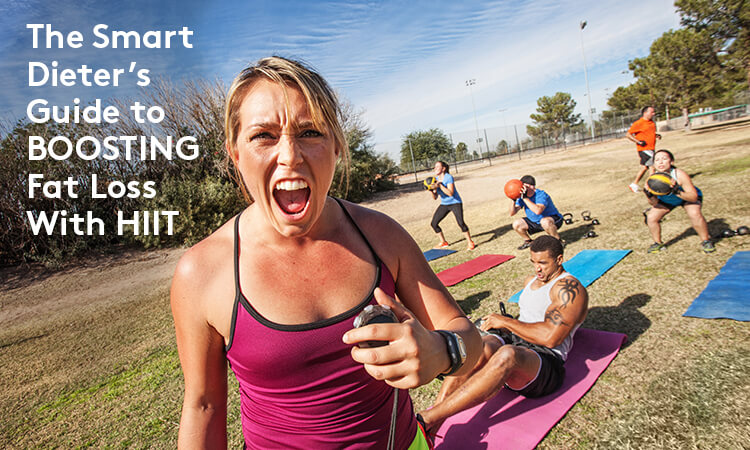Do you get excited to go to the gym and do another monotonous 45-minute cardio workout?
Probably not. And if you’re trying to burn fat, you shouldn’t be using lengthy walks on the treadmill to achieve your goals. Instead, you should be using high-intensity interval training (HIIT) workouts.
Smart dieters turn to HIIT because it’s a quicker, more efficient way to burn fat and lose weight. This article discusses:
- what HIIT workouts are
- the expected benefits of HIIT
- why HIIT workouts burn fat and how they measure up to low-intensity steady-state cardio
- how to structure HIIT workouts to achieve your goals

What is high-intensity interval training?
High-intensity interval training is what the name suggests: a style of exercise where you vary between intervals of high-intensity and low-intensity exercise or rest. One of the most basic examples of a HIIT workout is sprinting at your maximum level for 30 seconds followed by a 30 second walk. You’ll repeat the interval between 10 and 15 times.
The example above is a 1:1 HIIT ratio. However, you can use different ratios to alter the effects of the workout. For example, you can work for 20 seconds and “rest” for 10 seconds. This is the very method, first introduced by the Japanese researcher Izumi Tabata, that led to the popularity now enjoyed by HIIT methods.
3 benefits of HIIT
While fat loss is the primary goal of any HIIT workout, there are other benefits to take note of as a smart dieter. These include:
- Metabolism boost – HIIT causes Excess Post-Exercise Oxygen Consumption, or EPOC. This gives your metabolism a boost for up to 48 hours after your workout and helps you burn fat long after you’ve left the gym.
- Efficiency – HIIT workouts are typically 10 to 15 minutes long. This means you can always fit them into your schedule and you can do them virtually anywhere –at the park, at home, at the gym, and even while traveling.
- No equipment required – if you want to work out from home without paying for a gym membership, you can do so with HIIT. Many HIIT workouts use your bodyweight, meaning no equipment is needed.
As well as these benefits there is one main reason why most people turn to HIIT: fat loss.
Why to use HIIT for fat loss and how HIIT measures up to low-intensity steady-state cardio
Any type of cardiovascular exercise will cause you to burn fat and carbohydrates. However, the intensity of your cardiovascular exercise will affect how much fat and carbs you burn during your workout. This is because as workout intensity increases, your body relies on muscle glycogen rather than fat stores for energy. Put simply, this means that the harder you work out, the more your body will use carbohydrates rather than fat for energy during the workout.
This is why people believe that low-intensity cardio is best for fat loss: it keeps your body in the target “heart rate zone” where the workout isn’t too intense and your body burns glycogen stores rather than fat. However, HIIT is superior for fat loss for two main reasons.
1: You burn more calories per session
High intensity workouts burn more calories than low-intensity workouts, and with more calories burned, more fat is lost. This is particularly true for HIIT workouts because they keep your heart rate out of the high zone where your body begins to rely on glycogen rather than fat.
Consider this: if you jog multiple times per week and burn 200 calories each time you exercise, 100 calories could easily come from fat stores in the body. But if you follow a HIIT workout the same number of times per week, you could easily burn 400 calories or more and 150 calories or more could come from fat stores. This means that you’re spending less time at the gym while burning more calories from fat, making it simpler and more efficient to achieve your weight loss goals.
2: Shorter cardio sessions accelerate muscle growth
Cardiovascular exercise itself doesn’t impair muscle growth, but too much cardiovascular exercise does. What constitutes too much typically depends on the duration of your individual cardio sessions and the total amount of cardio you perform each week. That being said, you should use HIIT workouts for shorter cardio durations and perform these workouts only 2 or 3 times per week to ensure you’re accelerating, rather than impairing, muscle growth.
How to structure HIIT workouts for weight loss goals
There are countless variations on HIIT workouts and a number of ways you can customize a workout to best suit your needs. Factors include:
- type of cardio
- workout length
- workout frequency
- high-intensity interval duration and intensity
- low-intensity interval duration and intensity
This essentially means you can design a workout that you enjoy, provided you follow these 3 basic pointers:
-
Speed – HIIT workouts vary in speed rather than intensity. If you increase intensity too much, you run the risk of turning it into a resistance workout and losing the HIIT benefits.
-
Vmax level of exertion – like speed, the time you spend at the highest level of exertion, or the Vmax level, matters. If you don’t spend enough time there, you won’t get the full benefits of a HIIT workout, and if you spend too much time there, you run the risk of burning yourself out.
- Make workouts progressively harder – HIIT will only work if you continue to make your workouts progressively more challenging. This might mean that you begin with a 1:2 ratio of work to rest (i.e. 30 seconds of work and 60 seconds of rest) and work up to a 1:1 ratio. This is important so that you can enjoy continued benefits from the process.
HIIT your way to fat loss
If you feel like you’re dieting smartly but your weight loss has stalled, HIIT can reinvigorate your efforts. And, using the guidelines above, weight loss is just workouts away.




